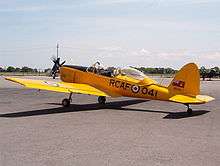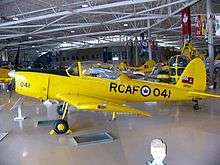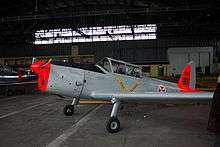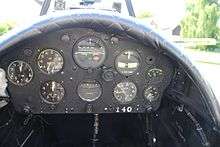de Havilland Canada DHC-1 Chipmunk
| DHC-1 Chipmunk | |
|---|---|
.jpg) | |
| A Chipmunk 1 in 2013 | |
| Role | Trainer |
| Manufacturer | de Havilland Canada |
| Designer | Wsiewołod Jakimiuk |
| First flight | 22 May 1946 |
| Introduction | 1946 |
| Retired | 1972 (Canada) |
| Status | Out of production, in active service |
| Primary users | Royal Air Force Royal Canadian Air Force Portuguese Air Force Belgian Air Force |
| Produced | 1947–1956 |
| Number built | 1,284 (including Canadian, British, and Portuguese production)[1] |
The de Havilland Canada DHC-1 Chipmunk is a tandem, two-seat, single-engined primary trainer aircraft developed and manufactured by Canadian aircraft manufacturer de Havilland Canada. It was developed shortly after the Second World War and sold heavily throughout the immediate post-war years, being typically employed as a replacement for the de Havilland Tiger Moth biplane.
The Chipmunk holds the distinction of being the first postwar aviation project conducted by de Havilland Canada. It performed its maiden flight on 22 May 1946 and was introduced to operational service that same year. During the late 1940s and 1950s, the Chipmunk was procured in large numbers by military air services such as the Royal Canadian Air Force (RCAF), Royal Air Force (RAF), and several other nation's air forces, where it was often utilised as their standard primary trainer aircraft. The type was also produced under licence by de Havilland in the United Kingdom, who would produce the vast majority of Chipmunks, as well as by OGMA (Oficinas Gerais de Material Aeronáutico) in Portugal.
The type was gradually phased out of service from the late 1950s onwards, often being replaced by jet-propelled trainers such as the BAC Jet Provost. Few aircraft were left in military service by 1970. However, many of the Chipmunks that had been formerly in military use were sold on to civilians, either to private owners or to companies, where they were typically used for a variety of purposes, often involving the type's excellent flying characteristics and it capability for aerobatic maneouvers. More than 70 years after the type having first entered service, hundreds of Chipmunks remained airworthy and were in operation around the world.[1]
Development
Origins

Immediately following the conclusion of the Second World War, there was a desire amongst some figures within Canadian aviation circles to take advantage of the recently expanded aircraft manufacturing industry which had been rapidly built up in Canada during the peace years. Out of this desire, it was decided to embark on developing aircraft which would replace designs which were obsolete in light of the rapid advances made during the war in the aviation field. One such company, de Havilland Aircraft of Canada Ltd, was interested in developing their own aircraft designs, and chose to focus on producing a contemporary aircraft for pilot training, specifically intending for the envisioned type to serve as a successor to the de Havilland Tiger Moth biplane trainer, many thousands of which having been widely used during the recent war by various military services and had been developed prior to the conflict.[1][2]
Wsiewołod Jakimiuk, a Polish pre-war engineer, served as the principal designer and led the design team in the development of the new aircraft, which became known as the Chipmunk. He designed a cantilever monoplane that incorporated numerous advances over typical trainer aircraft then in widespread service.[2] These included an enclosed cockpit complete with a rear-sliding canopy, and various aerodynamic features to manage the aircraft's flight performance. Strakes were fitted to deter spin conditions and stall breaker strips along the inboard leading edges of the wing ensured that a stall would originate in this position as opposed to the outboard section.[2] The Chipmunk would become the first indigenous aircraft design to be produced by de Havilland Canada.[1]
On 22 May 1946, CF-DIO-X, the Chipmunk prototype, perform its maiden flight, flying for the first time at Downsview, Toronto.[1] It was piloted by Pat Fillingham, a test pilot which had been seconded from the parent de Havilland company.[3] The prototype was powered by a 145 hp (108 kW) de Havilland Gipsy Major 1C air-cooled reciprocating engine, this was replaced on the production version of the Chipmunk by a 145 hp (108 kW) inline de Havilland Gipsy Major 8 engine.
Production
de Havilland Canada constructed the type at their factory in Downsview, Toronto, Ontario, where they produced a total of 217 Chipmunks during the 1940s and 1950s, the final example of which having been completed during 1956.[4] In addition, a total of 1,000 Chipmunks were produced under licence in the United Kingdom by British aircraft manufacturer de Havilland; manufacturing was initially performed at the company's facility at Hatfield Aerodrome, Hertfordshire; it was later decided to transfer production to another of their plants, located at Hawarden Aerodrome, Broughton near Chester.[5] A further 66 Chipmunks were licence-manufactured by OGMA (Oficinas Gerais de Material Aeronáutico), at Alverca from 1955 to 1961 in Portugal for the Portuguese Air Force.[6]
Both British-built and early Canadian-built Chipmunks are notably different from the later Canadian-built RCAF/Lebanese versions. The later Canadian-built aircraft were fitted with a bubble canopy, which replaced the multi-panelled sliding canopy that had been used upon early Canadian-produced Chipmunks, along with all of the Portuguese and British-built aircraft.[1] On the early-built canopy, the rearmost panels were intentionally bulged in order to provide the instructor's position with superior visibility.[7] British-built Chipmunks also differed by a number of adjustments to suit the expressed preferences of the RAF. These included the repositioning of the undercarriage legs, the adoption of a variable-pitch propeller, anti-spin strakes, landing lights, and an all-round stressed airframe.[7]
At one point, work was being conducted on a derivative of the Chipmunk which featured an extensive cabin modification in order to accommodate a side-by-side seating arrangement; the aircraft, which was referred to as the DHC-2, ultimately remained unbuilt.[8] The DHC-2 designation was subsequently reallocated to the company's next product, the DHC-2 Beaver.[1]
Design
.jpg)
The de Havilland Canada DHC-1 Chipmunk is a two-seat, single-engine aircraft that has been heavily used as a primary trainer aircraft.[1][2] The basic configuration of the aircraft included a low-mounted wing and a two-place tandem cockpit, which was fitted with a clear perspex canopy covers the pilot/student (front) and instructor/passenger (rear) positions and provided all-round visibility.[1] The Chipmunk uses a conventional tailwheel landing gear arrangement and is fitted with fabric-covered flight control surfaces; the wing is also fabric-covered aft of the spar.[7][1] In terms of handling, the Chipmunk exhibited a gentle and responsive flight attitude. Early production aircraft were only semi-aerobatic, while later production models were almost all fully aerobatic.[1][7]
The structure of the Chipmunk makes heavy use of metal, the majority of the airframe being composed of a stress-skinned alloy; this allowed the adoption of thinner wings and consequently provided for increased performance as well as a greater degree of durability.[2] Numerous features were incorporated in order for the type to better perform in its trainer role, including hand-operated single-slotted wing flaps, anti-spin strakes, disc brakes on the wheeled undercarriage, a thin propeller composed of a solid lightweight alloy, the adoption of an engine-driven vacuum pump in place of external venture tubes to power cockpit instrumentation, electric and Coffman cartridge engine starters as alternative options, cockpit lighting, onboard radio system, and an external identification light underneath the starboard wing.[2]
In civilian service, individual aircraft would often be modified. Examples of these adaptations include extensive modification programmes in order to perform competitive aerobatics, for which aircraft are often re-engined and fitted with constant speed propellers and inverted fuel systems; larger numbers of Chipmunks have been tasked as dedicated glider tows. It has become commonplace for Chipmunks to be re-engined, typically using the 180 hp Lycoming O-360.[1]
Operational history


United Kingdom
The Royal Air Force (RAF) had been one of the operators to quickly take notice of the new Canadian trainer, and encouraged its formal evaluation with an eye towards procuring it. Accordingly, a total of three Chipmunk aircraft were transported to the United Kingdom, where they underwent an evaluation by the Aeroplane and Armament Experimental Establishment (A&AEE) at RAF Boscombe Down, Wiltshire.[1] Based upon this favourable evaluation, the British Air Ministry proceeded to formulate and release Air Ministry specification T.8/48 around the type as a replacement for the de Havilland Tiger Moth biplane then in use. This specification was also contested by the rival Fairey Primer, which lost out to the Chipmunk and ultimately did not enter production.[1]
As such, the fully aerobatic Chipmunk was ordered to serve as an ab initio trainer for new pilots. The RAF received a total of 735 Chipmunks, which were designated in British service as the de Havilland Chipmunk T.10; these aircraft had been manufactured in the United Kingdom by de Havilland, the parent company of de Havilland Canada.
The Chipmunk T.10 initially served with Reserve Flying Squadrons (RFS) of the RAF Volunteer Reserve (VR), as well as the University Air Squadrons. During 1958, multiple Chipmunks were pressed into service in Cyprus for conducting internal security flights during the height of civil unrest during the Cyprus dispute.[7] Eight disassembled aircraft were flown out in the holds of Blackburn Beverley transports; following their reassembly, these Chipmunks, which were operated by No. 114 Squadron, were operated for some months into 1959.[9]
From 1956 to 1990, the Chipmunks of the RAF Gatow Station Flight were used to conduct covert reconnaissance missions by BRIXMIS over the Berlin area.[10] A number of Chipmunk T.10s were also used by the Army Air Corps and Fleet Air Arm to conduct primary training. Notably, Prince Philip had his first flying lesson in a Chipmunk in 1952; he has declared the type to be his favourite aircraft.[1]
Until 1996, Chipmunks remained in service with Air Training Corps (ATC) for Air Experience Flights (AEFs); the final of these AEF flights to use the Chipmunk was No. 10 Air Experience Flight, RAF Woodvale, when they were replaced by the Scottish Aviation Bulldog. The last Chipmunks in military service are still operated by the British historic flights – the RAF Battle of Britain Memorial Flight (including one of the Gatow aircraft), the Royal Navy and Army historic flights, to keep their pilots current on tailwheel aircraft. In addition, the cockpit sections of some former RAF Chipmunks have been used as ground training aids; these are colloquially known as "Chippax" trainers.[11][N 1]
Canada
In 1948 the RCAF accepted its first DHC-1 Chipmunk trainers, having received the first batch of a total production run of 217 Chipmunks that would be manufactured in Canada.[12] The Chipmunk was the first Canadian-designed aircraft to be made abroad under licence and as such, the majority of the home-grown production destined for the RCAF. However, Canadian-built Chipmunks were also delivered to some overseas customers, including Egypt, Lebanon and Thailand.[12]
Of the 113 Chipmunks that would enter RCAF service, 79 of these were assigned to serve as ab initio trainers, while 34 were assigned to flying clubs for use in refresher training for RCAF Reserve pilots.[13] The type remained in use as a trainer until the early 1970s, the last example being retired from service by the Canadian Armed Forces during 1972, three years after unification of the Canadian Armed Forces.[12] The Chipmunk's long service was due, in part, to its fully aerobatic capabilities and superb flying characteristics, which had contributed towards pilots frequently referring to it as being "a delight to fly".[N 2]
On 2 June 2015, with the landing of his Chipmunk at Pearson International Airport in Toronto, Ontario, Canada, retired de Havilland Canada test pilot George Neal established a new world record for the oldest active licensed pilot at the age of 96 years 194 days.[16][17]
Others
From the 1950s onward, the Chipmunk also became a popular civilian aircraft, the type having being used for various roles, such as pilot training, aerobatics and crop spraying. The majority of civilian aircraft are ex-military that had been resold and frequently modernised. It is also a mechanically sound aircraft and, consequently, many ex-RCAF Chipmunks have since remained operational for decades with various private owners and operators around the world.[14] By 2001, several hundred Chipmunks were reportedly operational in private service.[7]
Variants
Canadian-built

- DHC-1A-1 (Chipmunk T.1)
- Powered by de Havilland Gipsy Major 1C engine, only partially aerobatic.[1]
- DHC-1A-2
- Powered by de Havilland Gipsy Major 10 engine, only partially aerobatic.[1]
- DHC-1B-1
- Powered by de Havilland Gipsy Major 1C engine, fully aerobatic.[1]
- DHC-1B-2
- Powered by de Havilland Gipsy Major 10 engine, fully aerobatic.[1]
- DHC-1B-2-S1
- Powered by de Havilland Gipsy Major 10 for Royal Egyptian Air Force.[1]
- DHC-1B-2-S2
- Powered by de Havilland Gipsy Major 10 for Royal Thai Air Force.[1]
- DHC-1B-2-S3 (Chipmunk T.2)
- Powered by de Havilland Gipsy Major 10 for RCAF refresher training operated by Royal Canadian Flying Clubs.[1]
- DHC-1B-2-S4
- Version for Chile.[1]
- DHC-1B-2-S5 (Chipmunk T.2)
- Additional units built for Royal Canadian Air Force.[1]
British-built
- Chipmunk T.10 (Mk 10)
- de Havilland Gipsy Major 8 engined version for the Royal Air Force, 735 built.[1]
- Chipmunk Mk 20
- Military export version of T.10 powered by de Havilland Gipsy Major 10 Series 2 engine, 217 built.[1]
- Chipmunk Mk 21
- Civil version of Mk 20 but fitted to civil standards, 28 built.[1]
- Chipmunk Mk 22
- T.10 converted for civilian use.[1] Conversion also involves restamping the Gipsy Major 8 (which is military) to a model 10-2 (which is civil).
- Chipmunk Mk 22A
- Mk 22 with fuel tankage increased to 12 Imperial gallons per side.[1]
- Chipmunk Mk 23
- Five converted T.10s powered by de Havilland Gipsy Major 10 Series 2 engine and with agricultural spray equipment.[5]
Portuguese-built
- Chipmunk Mk 20

Military version powered by de Havilland Gipsy Major 10 Series 2 (145 hp) engine, 10 built in UK followed by 66 built by OGMA.[6][1] From 1989 onward, seven aircraft where updated and modified at OGMA (5) and Indústrias Aeronáuticas de Coimbra (2) to be used by the 802 Sqn. "Águias" (Eagles) — Air Force Academy squadron. The main modification was the installation of a more powerful 180 hp Continental engine. Their main tasks are related to supporting the Air Force cadets aerial activities, mainly initial aptitude screening, glider tow and initial flight proficiency.
Civil conversions
- Masefield Variant
- Modifications or conversions by Bristol Aircraft Ltd. Modifications could be made on Chipmunk Mk 20, Mk 21, Mk 22 and 22A aircraft. The Chipmunks could be fitted with luggage compartments in the wings, a blown canopy, landing gear fairings and enlarged fuel tanks.[18]

- Super Chipmunk
- Single-seat aerobatic aircraft, powered by a 194 kW (260 hp) Avco Lycoming GO-435 piston engine, equipped with revised flying surfaces and retractable landing gear; four conversions.[19]

- Turbo Chipmunk
- In 1967–1968 a Chipmunk Mk 22A was converted, tested and flown by Hants and Sussex Aviation. The Chipmunk was fitted with an 86.42-kW (116-shp) Rover 90 turboprop engine.[20] and extra fuel capacity.
- Aerostructures Sundowner
- One Australian Chipmunk was fitted with a 180 hp (134 kW) Lycoming O-360 flat-four piston engine, wingtip tanks, clear-view canopy and metal wing skinning as the Sundowner touring aircraft.[21]
- Sasin Spraymaster
- Three Australian Chipmunks were converted into single-seat agricultural spraying aircraft.[21]
- Supermunk
- Designed and produced by officers of the British Gliding Association (BGA), Supermunk aircraft were converted from Chipmunks by fitting 180hp Avco Lycoming O-360-A4A engines for use as glider tugs.[22] Operated mainly by the Royal Air Force Gliding & Soaring Association (RAFGSA), the Supermunks are still in service and used at major gliding competitions in the United Kingdom. It is also used by the Portuguese Air Force Academy as basic training aircraft and as glider tug.
Scholl Super Chipmunk

A number of Chipmunks were modified as aerobatic aircraft in the United States as the "Super Chipmunk". Along with an uprated engine, the aircraft underwent an extensive makeover including clipping its wings, adding retractable landing gear, conversion to a single-seat layout, adding an autopilot and being fitted with a red, white and blue wingtip and tail smoke system. The control stick received a three-inch (76 mm) extension for greater control during extreme aerobatic maneuvers. For over 25 years the Super Chipmunk in its distinctive bright colour scheme of blue stars and sunburst effect was displayed by the aerobatic pilot Art Scholl.
Four Super Chipmunk conversions were modified, Scholl's N13A and N13Y, Harold Krier’s N6311V and Skip Volk's N1114V. Another more recent "Super Chipmunk" was converted by air show performer, Jim "Fang" Maroney who similarly modified an ex-RCAF example by strengthening the airframe, replacing the original 145 hp (108 kW) engine with a 260 hp (190 kW) version incorporating an inverted fuel and oil system, clipping three feet off the wings and adding 30% more rudder and 10% more elevator. A spatted landing gear was retained. Another similarly modified "Super Chipmunk", N1804Q, is owned and flown by air show pilot Greg Aldridge. N13Y is now on display at the National Air and Space Museum, Smithsonian Institution, Udvar-Hazy Center at Washington-Dulles International Airport.,[19] while N1114V is preserved at the EAA AirVenture Museum at Oshkosh, Wisconsin, USA.[23]
Operators
Civilian operators
Today, the Chipmunk remains popular with specialized flying clubs and is also operated by private individuals located in many countries worldwide.
Military operators
- Belgian Air Force In 1948, the Belgian air Force acquired two DHC-1 for evaluation as a possible replacement for their De Havilland Tiger Moth trainers. In the end, they choose the Stampe SV.4 instead and the two Chipmunks were sold off to the civilian market in 1955.
- Israeli Air Force – One aircraft only.
- Portuguese Air Force
- Squadron 802, Águias (Sintra)
- Air Force Academy (Academia de Força Aérea, Sintra)
- Spanish Air Force – One aircraft only.
- Rhodesian Air Training Group 4 Flying Training School. One aircraft WG354 preserved by South African Airforce Museum
- Royal Thai Air Force, developed as RTAF-4

- British Army – Army Air Corps
- Basic Fixed Wing Flight
- Army Air Corps Historic Aircraft Flight
- Royal Air Force
- RAFVR RFS, No.8 Sqn, No.31 Sqn, No.114 Sqn, No.275 Sqn, No.613 Sqn,[24] No.663 Sqn,[25] RAF Gatow (Berlin) Station Flight, University Air Squadrons, Air Experience Flights (Air Training Corps), Battle of Britain Memorial Flight
- Royal Navy – Fleet Air Arm
Specifications (DHC-1 Chipmunk)


Data from The de Havilland Canada Story,[26] BAE Systems[1]
General characteristics
- Crew: 2, student & instructor
- Length: 25 ft 5 in (7.75 m)
- Wingspan: 34 ft 4 in (10.47 m)
- Height: 7 ft in (2.1 m)
- Wing area: 172 ft² (16.0 m²)
- Empty weight: 1,517 lb (646 kg)
- Loaded weight: 2,014 lb (953 kg)
- Max. takeoff weight: 2,200 lb (998 kg)
- Powerplant: 1 × de Havilland Gipsy Major 1C, 145 hp (108 kW)
Performance
- Maximum speed: 120 kn, 138 mph at sea level (140 mph is also given) (222 km/h)
- Cruise speed: 90 kn
- Range: 225 NM (445 km)
- Service ceiling: 15,800 ft (5200 m)
- Rate of climb: 900 ft/min (274 m/min)
- Wing loading: 11.709 lb/ft² (57.82 kg/m²)
- Power/mass: .072 hp/lb (.113 kW/kg)
See also
- Aircraft of comparable role, configuration and era
- Related lists
References
Notes
- ↑ "Chippax" is an amalgamation of "Chipmunk" and "Pax" (an industry abbreviation for "passenger")
- ↑ The Chipmunk's flight characteristics have been favourably compared to that of the wartime Supermarine Spitfire.[14][15]
Citations
- 1 2 3 4 5 6 7 8 9 10 11 12 13 14 15 16 17 18 19 20 21 22 23 24 25 26 27 28 29 30 31 "De Havilland Canada DHC-1 Chipmunk." BAE Systems, Retrieved: 22 April 2017.
- 1 2 3 4 5 6 "de Havilland DHC1 Chipmunk T.Mk.10." de Havilland Aircraft Museum, Retrieved: 22 April 2017.
- ↑ Bain 1992, p. 141.
- ↑ Shields et al. 2009, p. 211.
- 1 2 Jackson 1987, p. 534.
- 1 2 Niccoli 1998, p. 27.
- 1 2 3 4 5 6 Fredriksen 2001, p. 92.
- ↑ "tiger moth | 1946 | 1203 |". Flightglobal.com. Retrieved 18 July 2014.
- ↑ FlyPast No. 282. February 2005, pp. 74–5.
- ↑ Shields et al. 2009, p. 276.
- ↑ "Chippax." Sywell Museum. Retrieved: 21 July 2011.
- 1 2 3 "de Havilland Canada DHC-1B2 Chipmunk 2." Canada Aviation and Space Museum. Retrieved: 26 July 2011.
- ↑ "De Havilland Canada DHC-1 Chipmunk." Canadian Centennial of Flight, 2009. Retrieved: 26 July 2011.
- 1 2 "de Havilland Canada DHC-1 Chipmunk." Canadian Warplane Heritage Museum, Retrieved: 26 July 2011.
- ↑ Shields, Hugh et al. 2009, pp. cover, back cover.
- ↑ Anonymous, "World's Oldest pilot." Aviation History, November 2015, p. 10.
- ↑ Lynch, Kerry. "George Neal Enters Guinness Record Book as Oldest Pilot." AIN Online, 22 June 2015.
- ↑ "Masefield Chipmunk." Flight, 15 July 1960.
- 1 2 "De Havilland-Canada DHC-1A Chipmunk, Pennzoil Special." Smithsonian, Air and Space Museum, 2005. Retrieved: 6 February 2009.
- ↑ Jackson 1987, p. 535.
- 1 2 Eyre 1983, p. 189.
- ↑ Taylor, John W. R. Jane's All the World's Aircraft 1982–83. London: Jane's Publishing Company, 1983. ISBN 0-7106-0748-2.
- ↑ "de Havilland DHC-1B-2 Chipmunk – N1114V." AirVenture Museum. Retrieved: 6 February 2009.
- ↑ Halley 2003, p. 21.
- ↑ Halley 2003, p. 76.
- ↑ Hotson 1983, p. 237.
Bibliography
- Bain, Gordon. de Havilland: A Pictorial Tribute. London: AirLife, 1992. ISBN 1-85648-243-X.
- Eyre, David. "Sasin/Aerostructures SA29 Spraymaster." The Illustrated Encyclopedia of Aircraft in Australia and New Zealand. Hornsby NSW: Sunshine Books, 1983. ISBN 0-86777-272-7.
- Fisher, Bill. Chipmunk: The First Forty Years. Berkhamsted, Hertfordshire, UK: de Havilland Type Design Organisation, 1986.
- Fisher, Bill. Chipmunk: The First Fifty Years. Berkhamsted, Hertfordshire, UK: de Havilland Type Design Organisation, 1996.
- Fredriksen, John C. International Warbirds: An Illustrated Guide to World Military Aircraft, 1914–2000. ABC-CLIO, 2001. ISBN 1-57607-364-5.
- Halley, J.J. Royal Air Force Aircraft WA100 to WZ999. Tonbridge, Kent, UK: Air-Britain (Historians) Ltd., 2003. ISBN 0-85130-321-8.
- Hotson, Fred. The de Havilland Canada Story. Toronto: CANAV Books, 1983. ISBN 0-9690703-2-2.
- The Illustrated Encyclopedia of Aircraft (Part Work 1982–1985). London: Orbis Publishing.
- Jackson, A.J. British Civil Aircraft since 1919 Volume 2. London: Putnam, 1974. ISBN 0-370-10010-7.
- Jackson, A.J. De Havilland Aircraft since 1909. London, Putnam. Third edition, 1987. ISBN 0-85177-802-X.
- Niccoli, dott Riccardo. "Atlantic Sentinels: The Portuguese Air Force since 1912". Air Enthusiast, No. 73, January/February 1998. pp. 20–35. Stanford, UK: Key Publishing. ISSN 0143-5450.
- Shields, Hugh et al. The de Havilland Canada DHC-1 Chipmunk: The Poor Man's Spitfire. St. Thomas, Ontario: SBGB Publishing, 2009. ISBN 978-0-9812544-0-1.
External links
| Wikimedia Commons has media related to DHC-1 Chipmunk. |
- RAF Museum
- National Air Force Museum of Canada
- "The D.H. Chipmunk" a 1947 Flight article
- "The Turbine Chipmunk" a 1967 Flight article on the Rover TP.90 experiments
- "In Vogue Again: The de Havilland Chipmunk" a 1974 Flight article
- Article on the RAF BBMF (Battle of Britain Memorial Flight)
